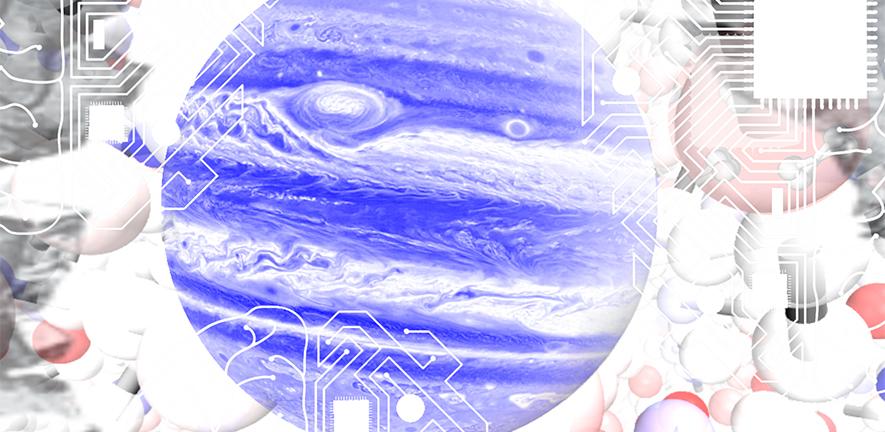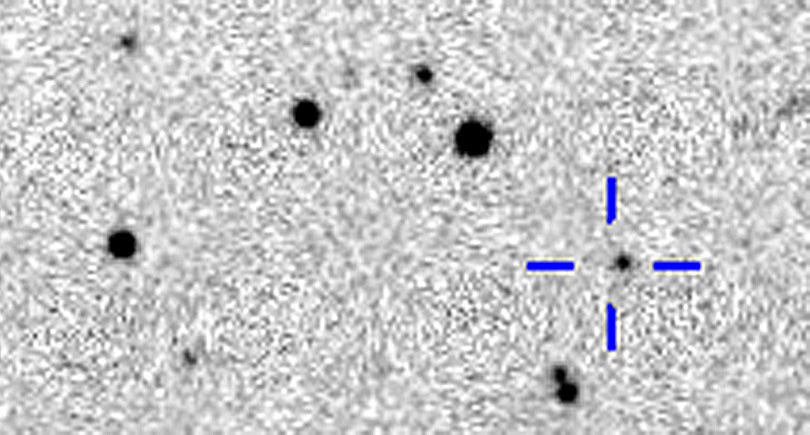Media
Transcript
Welcome back to Fridays, everyone! Normally, being back after the summer hiatus would be a big deal, but this is 2020, all year, and so… what even is time? It’s still late March, right?
Time is weird these days. Do you know what else is weird? Metallic hydrogen. I’m still trying to wrap my brain around this first story.
Dr. Pamela has told us many times that, to astronomers, there is “hydrogen, helium and then everything else”. Planetary scientists have a more complex table of elements. You have your noble gases, your salts, your metals, and your rare earth elements. These make up most everything. So it’s always interesting when an element doesn’t behave in a way we’re used to here on Earth.
In the case of gas giants, there’s metallic hydrogen in them thar cores! (Sorry.)

Dense metallic hydrogen has been theorized for over a century. The hydrogen acts like an electrical conductor, and it makes up the interiors of giant planets like Jupiter, Saturn, Uranus, and Neptune. While scientists knew it was there, they couldn’t explain how it changed.
Now, researchers using a combination of artificial intelligence and quantum mechanics have been able to mimic the interactions of the hydrogen particles. They found that the hydrogen doesn’t have a sudden transition from molecular gas to metal but rather transitions smoothly and gradually as the pressure increases.
What’s fascinating to me about this story is that they tried to analyze the transition in an experimental fashion for years, using diamond anvils to compress the hydrogen atoms. Diamond, of course, is the hardest substance on Earth, but even it could not withstand the immense pressure required, and the anvils would fail. So much for a diamond is forever, y’all. Also, talk about an expensive experiment.
Then scientists tried theoretical calculations, and the computational power required to crunch the numbers with the relevant equations also turned out to be too much. None of our current supercomputers have the processing power.
Enter in AI and quantum mechanics. The machine learning mimicked the interactions, overcoming all the limitations of trying to do the quantum mechanical calculations.
So why is the transition smooth and gradual instead of sudden as it is for most substances? To have a substance change its basic form, it has to have a critical point where those two forms – for example gas and liquid – exist simultaneously, which means on either side of the point, you have one form or the other. We’re familiar with the transition between liquid water and water vapor, and we know this happens at 100 degrees Celsius. It’s an “exposed” critical point and has a first-order phase transition.
As the press release explains: A common example of a first-order phase transition is boiling liquid water: once the liquid becomes a vapour, its appearance and behaviour completely change despite the fact that the temperature and the pressure remain the same.
However, hydrogen’s critical point is apparently hidden. Since there isn’t one specific combination of temperature and pressure that makes hydrogen undergo a transformation, it does so gradually. As you might guess, this type of transition leads to some other interesting phenomena like density and heat capacity maxima, which I won’t get into here. Mostly because that’s another show.
Now researchers have to focus on the actual physical properties of dense hydrogen, and as those results come out, we’ll bring them to you here on the Daily Space.
From the interiors of gas giants to their moons, I find them all fascinating. Some of you may be aware, however, that my favorite moon is Io, which is the closest of the Galilean moons to Jupiter. Io is the most volcanically active body in our solar system, but it doesn’t have plate tectonics.

In fact, all the Galilean moons are hotter than they should be at their distance from the Sun, and researchers have been trying to understand why. The explanation up until now has been that Jupiter’s tidal pull on the moons is strong enough to create a flex and release that heats up the cores of the planets. This reaction is called tidal heating.
I always explain this phenomenon by taking a rubber ball and squeezing it repeatedly until the surface heats up and cracks a little. The squeezing motion causes the heat.
In a new study in the Geophysical Research Letters, research shows that it may be the moon-moon interactions that are responsible for heating the moons more than it is Jupiter’s gravitational influence.
Lead author Hamish Hay remarked: It’s surprising because the moons are so much smaller than Jupiter. You wouldn’t expect them to be able to create such a large tidal response.
So how do the moons exert this influence on one another? Tidal resonance. Hay goes on to explain: Basically, if you push any object or system and let go, it will wobble at its own natural frequency. If you keep on pushing the system at the right frequency, those oscillations get bigger and bigger, just like when you’re pushing a swing. If you push the swing at the right time, it goes higher, but get the timing wrong and the swing’s motion is dampened.
To get the right resonance, you need both Jupiter’s influence and the influence of the other moons. This is due to the depth of the oceans on these moons, or in the case of Io, it’s magma ocean. The oceans are too deep for just Jupiter alone to cause all the heating of ice and rock that we find.
Next up, the team wants to examine what happens if the resonances become too extreme. I’m interested to see what they learn. It would be neat to add their research into a possible citizen science project on Io.
Citizen science is a great way to get more people involved in finding and understanding astronomical objects. In fact, a Planetary Society grant winner has found an asteroid using his personal telescope, which the grant paid to update.

Amateur astronomer, or as I prefer to call him “astronomer”, Leonardo Amaral of Brazil recently found asteroid 2020 QU6. Why is this news? Because the asteroid is about a kilometer wide, and it’s thought that we had already found more than 90% of asteroids that size. 90% isn’t 100%, though, so while this asteroid passed safely by Earth at a respectable distance of 40 million kilometers, it’s clear there is more work to be done to protect us from potentially harmful near-Earth asteroids.
Reminder, though, as Planetary Society Chief Scientist Bruce Betts states: In the news, we hear more and more frequently about asteroid discoveries primarily because we are getting better at finding and tracking near-Earth asteroids. There aren’t suddenly more asteroids, we’re just getting better at seeing them.
And thank you to those astronomers who continue to help find these asteroids and to the grants which help them look.
One final update for today. Thirty days ago, we reported to you (wait… how has a month gone by?) that the Arecibo radio telescope was damaged when a cable snapped. While the latest news states that no cause has yet been determined, the team is working to finish a full evaluation of the damage. Nothing can be done until a safety plan is in place, and that safety plan depends on structural analysis.

Observatory Director Francisco Cordova notes: This is a big and complex facility, so it is taking some time to ensure we are doing things right.
Agreed. Let’s not risk anyone for the sake of rushing repairs forward.
In the meantime, Arecibo’s Light Detection and Ranging (LIDAR) facility remains in operation as it was not damaged, so when astronomers like Leonardo find those asteroids, we can still determine their composition. We’ll continue to bring you updates on the repairs as we receive them.
Learn More
How Hydrogen Becomes a Metal Inside Giant Planets
- University of Cambridge press release
- “Evidence for Supercritical Behaviour of High-Pressure Liquid Hydrogen,” Bingqing Cheng et al., 2020 Sep. 9, Nature
Jupiter’s Moons Could Be Warming Each Other
- The University of Arizona press release
- “Powering the Galilean Satellites with Moon-Moon Tides,” Hamish C. F. C. Hay, Antony Trinh & Isamu Matsuyama, 2020 July 19, Geophysical Research Letters
Amateur Astronomer Discovers Large Near-Earth Asteroid
Update on Arecibo Observatory Facility
Credits
Written by Beth Johnson
Hosted by Beth Johnson
Audio and Video Editing by Ally Pelphrey
Content Editing by Beth Johnson
Executive Producer Pamela Gay
Intro and Outro music by Kevin MacLeod, https://incompetech.com/music/


 We record most shows live, on Twitch. Follow us today to get alerts when we go live.
We record most shows live, on Twitch. Follow us today to get alerts when we go live.